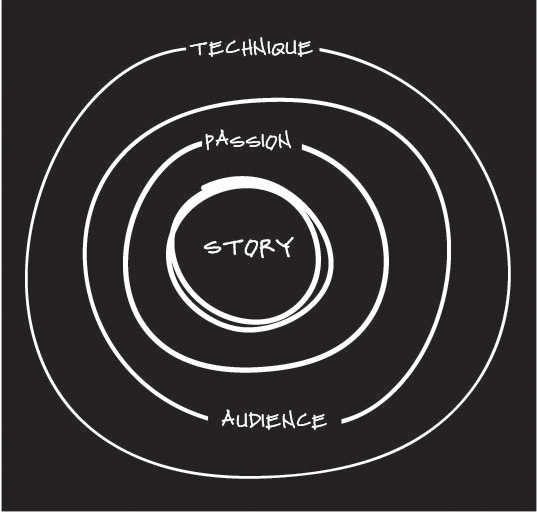By Brianna Cutts
A first glance at a playful panel discussion at the Western Museums Association 2013 Annual Meeting Program
What I love most about designing exhibitions is the opportunity to tell stories in three dimensions. For me, individual exhibits become backdrops for visitors to immerse in different parts of a larger story, where objects and interactives function as props that engage bodies, minds and feelings.
Early in my career, I believed that the most challenging part of the creative process of exhibition design was figuring out these backdrops and props. But, I now know that design is the easy part — defining the story is the challenge, the problem that needs solving.
Like most things, there’s not just one way to solve the problem of defining an exhibition story. Luckily, our field of talented museum professionals offers extensive expertise about the exhibition development process. This expertise resides in books, blogs, journals, conferences, and impromptu conversations.
For some of us, including my colleague Dave Stroud and myself, we continually search for ways to improve and perfect the creative process of exhibition development. Dave, who is Director of Interactive Exhibits at Thanksgiving Point Institute (TPI), and I met virtually about a year ago and quickly discovered our mutual interest, and since then have had animated email exchanges and phone calls to prepare for our upcoming session at the WMA 2013 Annual Meeting in Salt Lake City.
For Dave and me, this quote from Antoine de Saint Exupéry, author of the Little Prince, captures our mutual understanding:
“Perfection is finally attained not when there is no longer anything to add, but when there is no longer anything to take away...”
Exhibitions are a form of communication, and a focused message is imperative to effectively conveying the underlying ideas of any exhibition. Limiting extraneous and competing messages will help guests, team members, and stake holders all better understand their relationship to the exhibition.
Museum exhibitions that deliver content through innovative techniques can more deeply engage audiences. But, how do you get there?
Dave and I have planned a program session all about narrowing the focus of exhibitions. And to help keep us focused and narrowed in our delivery, Kirk Henrichsen, Curator of the Remote Art Collection at The Church of Jesus Christ of Latter-day Saints: Church History Department, will moderate the conversation.
In this session, we will share our strategies to narrow focus in exhibition projects. For both Dave and me, this begins with defining the problem. We’ve both learned that asking the right questions is critical to getting the right answer.
We’ll also emphasize the important of the creative process. Because exhibition development and design involve a complex process of standards and regulations that can sometimes overburden the creative process. Dave and I have both discovered that creativity takes time, is a little messy, and requires taking risks. Ultimately, we want to inspire session attendees to learn the rules so that you know how to break them.
During our session, Dave and I will share techniques we’ve developed to inspire innovation, risk taking and divergent thinking, techniques that can transform interpretive content into compelling stories told in immersive learning environments.
For Dave, this all begins with an extremely clear topic sentence. At TPI, Dave and his colleagues have developed an approach to address their needs as museum professionals working in and across multiple venues. The method provides continuity of exhibition development process regardless of subject content, and helps every team member understand the over-arching goals of an exhibition so they can evaluate the choices available to them.
For me, it all begins with having passion for the story. Over the years of working at museums and in my role as Creative Director at The Sibbett Group, as well as teaching exhibition development at John F. Kennedy University, I’ve created a process that I call Story Orbit. Every exhibition begins with a story, which is at the core of the exhibition development process, but it a team’s passion, connection with audience, and engaging techniques that best tell that story.
Dave, Kirk, and I look forward to inspiring a lively conversation during our session. While our topic is all about narrowing the focus of exhibitions, we hope that our session widens the conversation about the creative process of exhibition development and design. We hope to see you there!
To attend this session at the 2013 Annual Meeting, please visit: http://www.regonline.com/WMA2013
Brianna Cutts is Creative Director of The Sibbett Group, an exhibit design firm that specializes in crafting sensory-rich interpretive experiences that inspire visitors of all ages to connect more deeply with history and the natural world. Her past work has been with museums and design consultancies, including IDEO, where she led teams as an environments designer. Brianna is also an adjunct faculty member at John F. Kennedy University, where she teaches a graduate-level Exhibition Development course in the Museum Studies department. Brianna holds a Master of Arts in Museum Studies from John F. Kennedy University, and a Bachelor of Science in Environmental Design from the University of California at Davis.









Comments
Hi Lisa, We won't have the proceedings available online in their entirety. We will be requesting that presenters write post-meeting blog posts about their respective topics though. Please check back in with the blog for updates!
Hi Lisa! While we won't be streaming sessions from WMA 2013 in Salt Lake City, we will be hosting PowerPoints and posting blogs by the presenters afterward. So, be on the look out!
This sounds like a wonderful session. Any chance it is available online for those not able to attend this year? Lisa
Add new comment